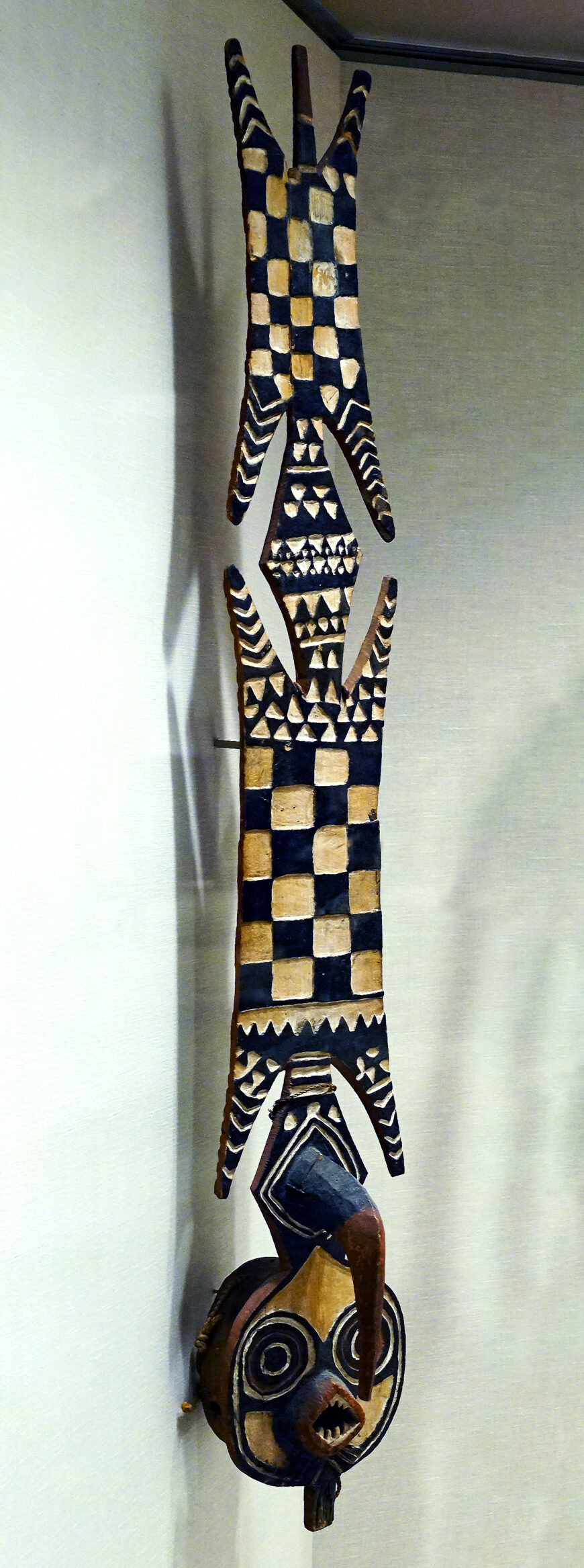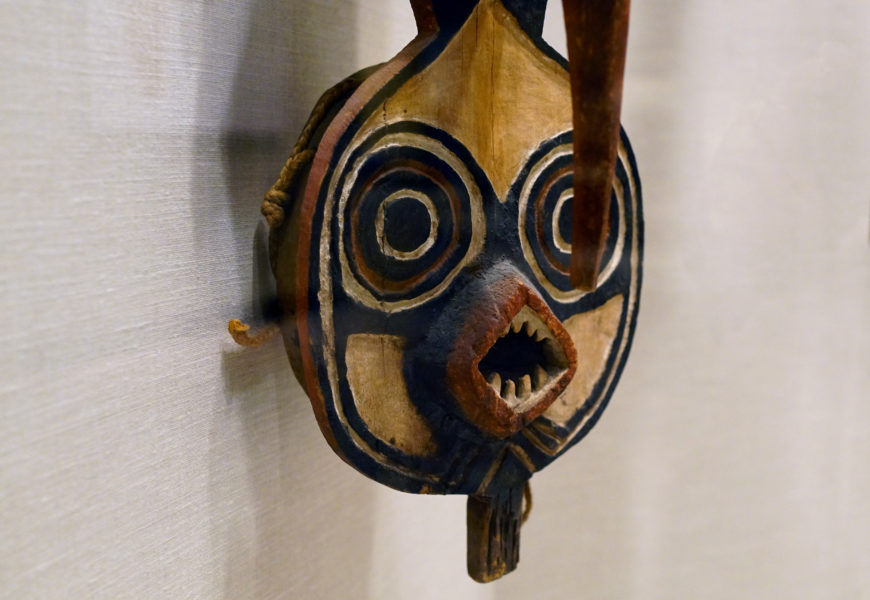
Mask (Nwantantay), 19th–20th century (Bwa peoples, Black Volta River region, Burkina Faso) wood, pigment, and fiber, 182.9 x 28.2 x 26 cm (The Metropolitan Museum of Art, New York; photo: Steven Zucker, CC BY-NC-SA 2.0)
Among the southern Bwa peoples in Burkina Faso, large wooden plank masks are carved to represent various flying spirits that inhabit the natural world. These spirits, though largely invisible, are associated with water and can take physical form as insects that gather around a pool after a heavy rain or as a large water fowl, like an ibis. Some Bwa describe a mythological encounter in which a flying spirit appeared before a human, offering protection and service. A tall plank mask was created after this encounter to honor the spirit and ensure its continued beneficence.
This mask has a circular face and tall, vertical superstructure with a series of downward-curving hooks projecting from both the front and the back. The protruding, diamond-shaped mouth with jagged teeth is pierced to allow the wearer to see. Brightly painted patterns in red, black, and white enhance the bold geometric shape of the plank. These designs refer to important Bwa ideals of social and moral behavior that are taught over the course of initiation. Each symbol has multiple levels of meaning that older initiates reveal gradually to novices as they mature. The checkerboard pattern of black and white squares, for example, refers on one level to the animal skins on which people sit: white representing the clean, fresh hides assigned to youths and black suggesting the darkened skins owned by elders. On a less literal level, the juxtaposition of white and black squares suggests abstract concepts such as the separation of good from evil, and of light from dark.

Face (detail), Mask (Nwantantay), 19th–20th century (Bwa peoples, Black Volta River region, Burkina Faso) wood, pigment, and fiber, 182.9 x 28.2 x 26 cm (The Metropolitan Museum of Art, New York; photo: Steven Zucker, CC BY-NC-SA 2.0)
Nwantantay masks are part of diverse ensembles of masks that represent animals, insects, humans, and supernatural creatures. The masks are commissioned and owned by large, extended families, or clans. The masks are used on several occasions throughout the year, including initiations, burials, annual renewal rites associated with planting and harvesting, and ceremonies celebrating the consecration of a new mask. These events are often competitive, with individual clans striving to present the most elaborate and inventive performance in the community. The mask is worn by a skilled dancer who secures it over his face by gripping a fiber rope on the mask’s back with his teeth. His body is concealed by a bushy fiber costume, traditionally dyed red or black, but now also seen in the bright green, yellow, and purple of European dyes. Accompanied by musicians playing flutes and drums and women singing songs, the masquerader moves rapidly, imitating the behavior of a flying spirit. With fiber costume twirling, he twists back and forth, then dips low to the ground, rotating the mask to suggest a disembodied apparition.
The tradition of carving and performing wooden masks is a recent one among the southern Bwa, adopted within the past hundred years from the neighboring Nunuma and Winiama peoples. Previously, the Bwa had created masks of leaves, vines, and grasses for use in ceremonies honoring Do, the earthly representative of the creator god. Resulting from the constant interplay of people and ideas, this example of cultural borrowing demonstrates the dynamism of masking traditions in the region and, in particular, the openness to innovation and adaptation that characterizes Bwa culture.
© 2006 The Metropolitan Museum of Art, New York (by permission)
Additional resources
This work at The Metropolitan Museum of Art
Read a Reframing Art History textbook chapter, The arts of Africa, c. 18th–20th century
Christopher D. Roy, The art of Burkina Faso from Art & Life in Africa (University of Iowa)
Smarthistory images for teaching and learning:
[flickr_tags user_id=”82032880@N00″ tags=”AfrMet,”]

